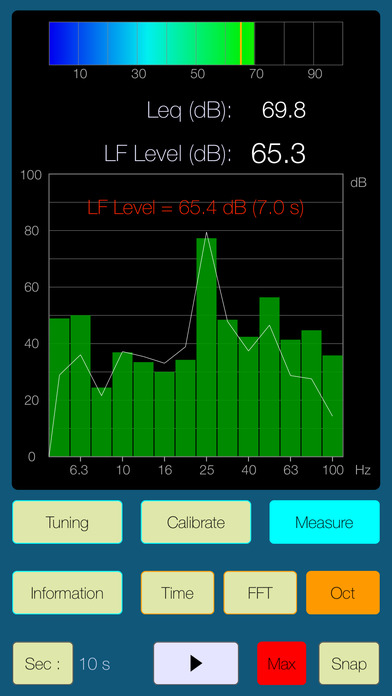
Low Frequency Detector
"Low Frequency Detector" is a new acoustic measurement tool for detecting the low frequency sound that is hard to hear in normal situation.
The human ear is not sensitive enough to low frequency sounds. If you are exposed to the noise of nearby construction and factories without noticing, you may have a bad feeling and a sense of oppression. In such cases, you can use this app to check what kind of low frequency noise is present.
In general, the low frequency sound is a sound wave from 1Hz to 100Hz. Depending on its frequency component and sound level, the degree of influence on the human body and the noise sensation is different.
This app allows you to examine the frequency component of low frequency sound by 1/3 octave band analysis and FFT analysis.
Features:
- Low frequency power level measurement less than 100Hz (LF Level): Flat characteristic, Updating indication of measurement period 1 sec.
- Power level measurement in the audible band (Leq): Flat characteristic, Updating indication of measurement period 200ms.
- 1/3 octave band analysis (OCT)
- FFT analysis (FFT)
- Time course graph (TIME)
- Snapshot (Snap) on the measurement display screen.
- Report function (Report): Analysis report of a peak LF Level with TIME, OCT and FFT.
- Measurement time: up to 60 sec
Functions:
The measurement analysis is performed in the following step. Be sure to set the measurement conditions in Step-1 once before starting the sound measurement.
1) Calibration (Calibrate): The reference signal (1kHz sine wave) is output to determine the reference noise level for the low frequency component. If the volume level of iPhone is set to about 20-50%, the calibration will automatically adjust it to the optimum volume level for the reference signal.
2) Measurement (Measure): Analyze a power level of low frequency sound.
- LF Level (dB): Low frequency power level less than 100Hz.
- Leq (dB): Sound power level with the frequency weight characteristic Z (Flat) of the audible band.
3) Measurement display: It can select either 1/3 octave band frequency analysis, FFT analysis or Time course graph. They are updated in real time.
4) Report: Measurement result report. It is effective when measuring for 10 seconds or more.
- Low frequency (LF) Level (dB): Time course graph with peak level noise level judgment (RED-very noisy, YELLOW-noisy, GREEN-normal) at the peak level.
- LF max (dB): maximum dB value of low frequency.
- OCT Band LF max (dB): maximum dB value in 1/3 octave band at LF max observation.
- Max Level Frequency (Hz): peak frequency at LF max observation.
Notes:
- The sound measurement of the low frequency range is a level difference with respect to the reference signal, which indicates the relative power level.
- The reference signal is output during calibration and sound level measurement.
- Do not change the volume level of iPhone after the calibration.
- White line in the OCT and FFT modes indicates frequency characteristics in frequency weight correction of G characteristics.
- Since iPhones built-in microphone has a lower sensitivity on the very low frequency range, it is not recommended to measure a huge volume sound near a very loud noise source.
- Since it takes a while for the observation value to stabilize immediately after the start of measurement, the maximum value is calculated from about 2 seconds later.
- In the case high power of 1kHz component is included in the measured noise source, the precision of measured value by this app largely decreases.
- Sudden noise or impulsive sounds are not low frequency noises in general.
- The previous calibration information can be maintained internally.
- The analysis results may vary due to individual differences in iPhone devices.
- The authorization to access built-in microphone and Photos will be confirmed by iOS system at first access.
Please visit our iOS app support page for more information.



